Top Prompts That Are Going Viral On TikTok And X In 2025


In Brief
In 2025, short-form content is driven by AI-powered prompts that help creators craft viral posts with greater precision, scale, and platform-specific impact.

In 2025, the process of going viral is less about chance and more about structure. TikTok and X, formerly Twitter, have shifted toward hybrid content: part commentary, part story, part meme. AI-generated content—especially when built with sharp, adaptable prompts—is central to how creators write their scripts, generate hooks, and optimize the message per platform.
Virality on these platforms isn’t just about aesthetics. It’s often built around concepts that trigger recognition, spark reactions, or deliver immediate utility. What defines high-reach content in 2025 is clarity, speed, and tone. Prompts help produce that structure on demand.
The following sections present 10 core themes used in viral content today, each with 2–3 prompt examples, context, and usage explanation.
Trending Prompt Category: “Give Me the Harsh Truth”
If you want to share sharp, honest insights that challenge common thinking or reflect your real experience — use prompts like these. They work best for creators sharing niche knowledge or bold opinions.
Prompt Examples
- Write a 15-second script where a founder gives the raw truth about building a business no one talks about.
- Create a post explaining what most creators still get wrong about “viral content” in 2025.
- What’s one industry myth that needs to be publicly corrected? Script it like a punchline for TikTok.
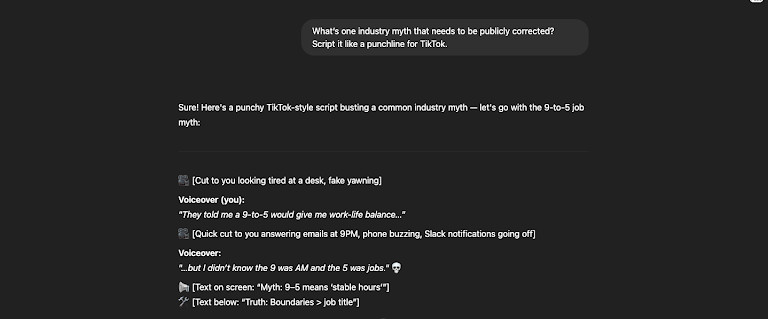
These prompts generate honest, experience-driven narratives that get engagement through relatability. On TikTok, they are typically paired with minimal editing and strong voice delivery. On X, they convert well into threads or standalone short posts.
Prompt Category: “Explain It Like I’m 5”
If your goal is to break down complex topics like finance, law, or tech in a way anyone can understand — these prompts help. They’re great for building clarity and trust.
Prompt Examples
- Turn this explanation of AI tokens into a 20-second video using simple language and examples.
- Create a Reels script that explains crypto wallets as if you’re talking to a beginner with zero knowledge.
- Write a TikTok about how taxes work for freelancers, using common items to explain each concept.
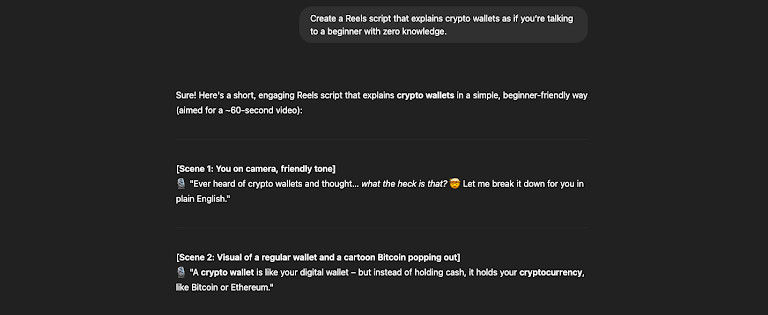
This format performs well because it invites viewers into the topic instead of excluding them. Clarity boosts retention. The prompt also makes it easier to repurpose long-form into short-form.
Prompt Category: “Do You See This Too?”
Want to comment on everyday behaviors or call out trends that feel off? These prompts help you connect through shared experiences and subtle irony.
Prompt Examples:
- Write a post about a trend people follow but never question, ending with: “Anyone else notice this?”
- Create a TikTok script that points out a strange but common habit in dating apps, using humor and pacing.
- Build a thread about how startup pitch decks all started looking the same in 2025.
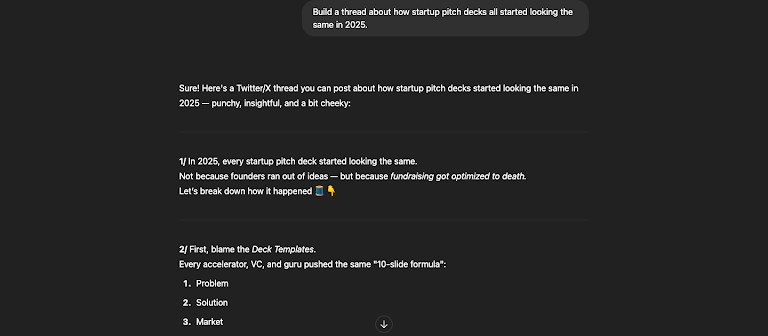
Content built from these prompts often goes viral because it validates shared behavior or triggers discussion. The prompt itself is structured around pattern interruption and reflection.
Prompt Category: “Break Down the Viral Thing Everyone’s Sharing”
If everyone’s talking about something viral and you want to add value instead of just repeating it — use prompts like these to break it down with context and insight.
Prompt Examples:
- Create a TikTok that explains why this week’s trending audio works so well—use rhythm and structure terms.
- Build a post that explains the business model behind the latest viral app. Keep it short but insightful.
- Make a script that explains why one viral format keeps working—reference algorithm behavior in 2025.
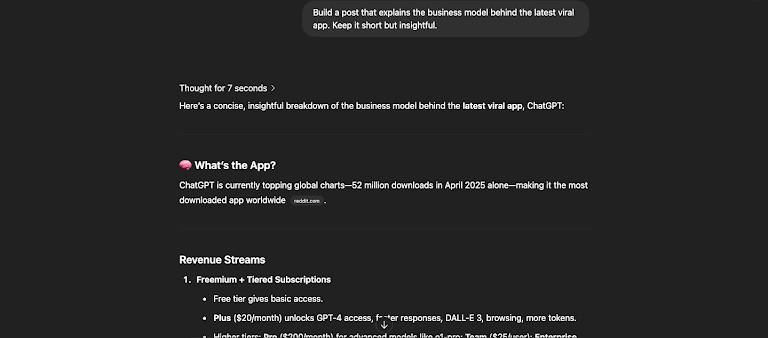
Used by marketers, analysts, and content strategists, these prompts generate content that benefits from trend waves without copying them blindly. This is often how experts gain followers fast.
Prompt Category: “If You’re in This Niche, Save This”
If you want viewers to save your video and come back to it, this format works. Use it to share practical tips, fast tutorials, or niche tools in your field.
Prompt Examples:
- Write a TikTok script that shares 3 tools every remote design team needs in 2025.
- Build a 20-second video outline listing 5 pricing models used by SaaS founders right now.
- Create a short-form script showing how to check if your domain is undervalued. Target indie hackers.
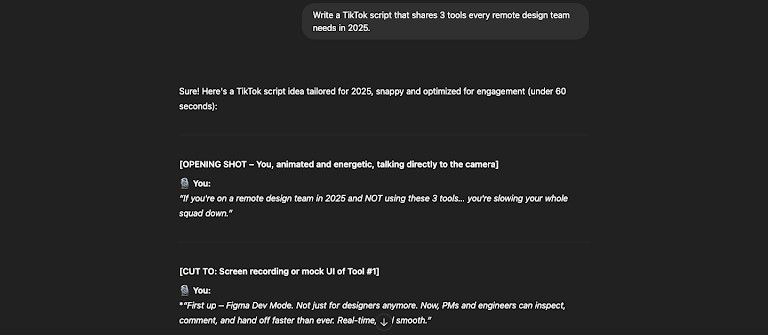
These prompts work because they set clear expectations, deliver usable content fast, and trigger saves. On X, they’re often reworked into carousels or short list threads.
Prompt Category: “Show Me the Workflow”
Use this format to walk people through your actual process. Whether it’s using AI tools, coding, or design, these prompts help you explain the steps clearly.
Prompt Examples:
- Script a 30-second walkthrough of a YouTube automation channel, from script to publish.
- Create a Reels script explaining how to use Midjourney for logo ideation.
- Build a carousel-style video breaking down a real AI prompt workflow for generating captions.
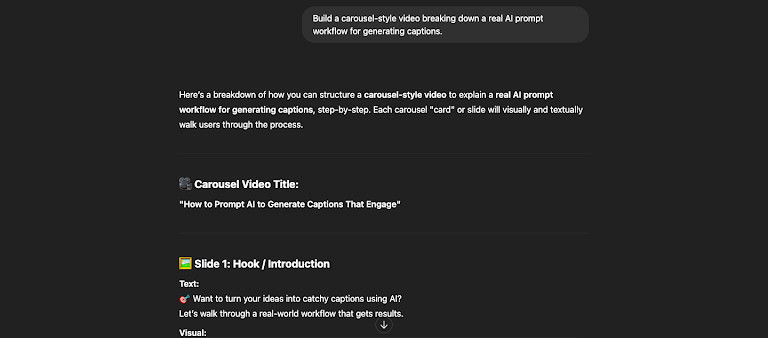
This structure also makes room for product marketing without being salesy. Creators using tools or services can highlight use cases in context.
Prompt Category: “What I’d Do If I Had to Start from Zero”
If you want to share a personal strategy, framework, or way to restart from zero — these prompts help turn that into relatable, shareable content.
Prompt Examples:
- Write a TikTok where you explain what you’d do in 30 days to grow an audience from scratch in 2025.
- Script a thread showing how someone could learn UX design in 3 months with only free tools.
- Build a story-based video explaining how to rebuild a consulting career with no prior clients.
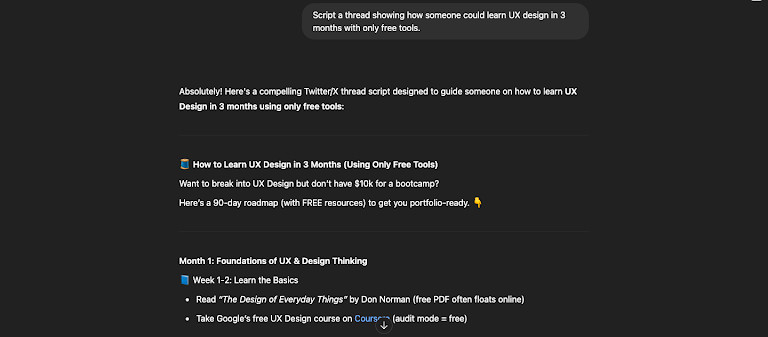
This format earns saves and shares because it shows pathways. The prompt invites the audience into the plan, and often gets re-used across industries.
Prompt Category: “Unpopular Opinion (That’s True)”
Want to say something people won’t expect but secretly agree with? These prompts help challenge popular ideas without being aggressive or clickbait.
Prompt Examples:
- Make a TikTok saying: “Remote work isn’t the future—it’s already being replaced.” Then explain.
- Build a video starting with: “Learning to code in 2025 is overrated. Here’s why.”
- Create a short post challenging how people use Notion to “stay productive.”

When used well, these prompts drive comments and re-posts. When overused, they become predictable. Framing and tone are essential.
Prompt Category: “Turn My Advice Into a Story”
If you want your advice to hit harder, turn it into a story. These prompts help make lessons more memorable by showing, not just telling.
Prompt Examples:
- Write a TikTok where someone learns a business lesson through a specific moment—keep it under 30 seconds.
- Create a short-form script based on the idea “Don’t chase multiple goals at once,” but show it in action.
- Build a thread starting with: “I once launched a startup while broke. Here’s what happened…”
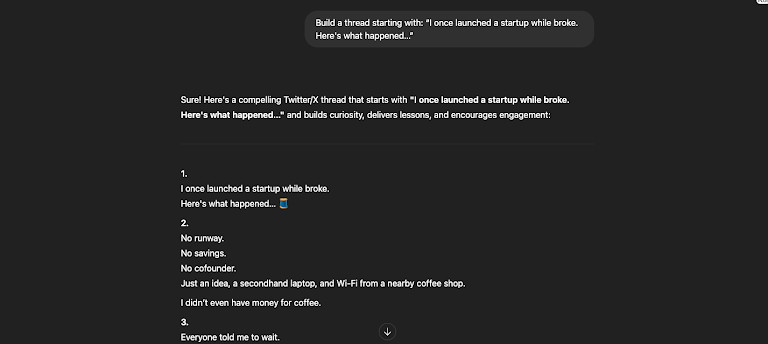
Narratives build emotional engagement and retention. On TikTok, this is often paired with B-roll or cinematic cuts. On X, it converts into mini-threads.
Prompt Category: “What No One Tells You About…”
These prompts are perfect when you want to reveal something useful that most people overlook. If your goal is to inform while entertaining, start here.
Prompt Examples:
- Make a TikTok that explains how most creators burn out—not during growth, but after going viral.
- Create a post explaining how algorithm updates on X affect content pacing and post timing.
- Script a 25-second breakdown of why most AI courses skip the hardest part—prompt testing.
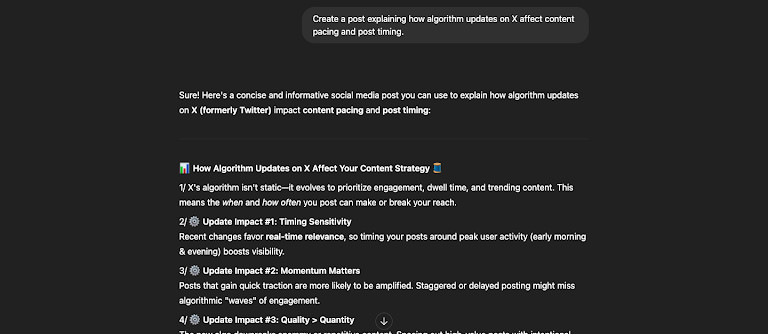
These prompts support content that makes people feel informed. They perform best when they reveal something overlooked.
Closing Perspective: Viral Prompts Are the Format Behind the Format
In 2025, most short-form content doesn’t start with editing or visuals. It starts with a clear prompt. The structure, tone, and rhythm are already set before production even begins.
A strong prompt now acts like a blueprint. It defines the flow of the video, frames the message, and helps align content with current platform trends. This foundation becomes even more critical as AI models evolve — such as the latest releases from Google DeepMind, which continue to shift what creators can automate or accelerate.
Those who learn to shape ideas through effective prompting gain a major edge. They test faster, refine smarter, and deliver tighter content. In a feed where attention is limited, the first second matters — and the prompt behind it often determines what gets noticed.
Disclaimer
In line with the Trust Project guidelines, please note that the information provided on this page is not intended to be and should not be interpreted as legal, tax, investment, financial, or any other form of advice. It is important to only invest what you can afford to lose and to seek independent financial advice if you have any doubts. For further information, we suggest referring to the terms and conditions as well as the help and support pages provided by the issuer or advertiser. MetaversePost is committed to accurate, unbiased reporting, but market conditions are subject to change without notice.
About The Author
Alisa, a dedicated journalist at the MPost, specializes in cryptocurrency, zero-knowledge proofs, investments, and the expansive realm of Web3. With a keen eye for emerging trends and technologies, she delivers comprehensive coverage to inform and engage readers in the ever-evolving landscape of digital finance.
More articles

Alisa, a dedicated journalist at the MPost, specializes in cryptocurrency, zero-knowledge proofs, investments, and the expansive realm of Web3. With a keen eye for emerging trends and technologies, she delivers comprehensive coverage to inform and engage readers in the ever-evolving landscape of digital finance.


















































